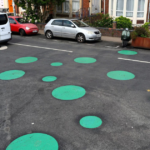
As art became a serious business over the last few decades, with record multimillion-dollar sales eclipsing one another, it seemed as though values could just rise in perpetuity. But this year has been a reality check.
High-end art sales have slumped. Sellers have withdrawn prominent works from major auctions at the last minute, for fear of jeopardizing artists’ markets. More than a dozen galleries have closed in Manhattan. Layoffs have begun to creep through the $65 billion industry, as one of its largest companies, Christie’s, saw revenue plunge. It took in $2.1 billion from auctions in the first six months of this year, down from $4.1 billion during the same period in 2022.
In today’s newsletter, I’ll explore some reasons the art business has slowed, and how it’s affecting a rising generation of artists.
The high point
Jaws dropped on a November evening in 2022, when collectors bought a record $1.5 billion worth of paintings in a single night at the Christie’s auction house. Buyers snapped up a parade of masterpieces by artists including Vincent van Gogh, Paul Cézanne and Gustav Klimt — all from the collection of the Microsoft co-founder Paul G. Allen.
That frenzied night seemed to forecast a booming future for an industry that had been getting hotter by the year. But it actually marked the peak of the market.
High interest rates and inflation bear some responsibility for the slowdown. Collectors who view artworks as financial assets have flinched at the rising costs of doing business and the diminished ability to get favorable loans to buy paintings they hope will appreciate in value. The supply of modern masterpieces has also decreased as potential sellers sit on their investments until economic conditions improve for the ultrawealthy.
Hesitation breeds uncertainty and doubt — dangerous emotions in an industry prone to mood swings. The more collectors fear a downturn, the more likely it becomes.
A pipeline problem
You could be excused for thinking the art world was still flying high. A jet-set crowd of wealthy collectors and influencers has shuttled around the world this summer from Venetian palazzos to Swiss chalets, stopping to party in Tokyo before ending their grand tour in the mountains of Aspen, Colo., for an art fair where participants enjoyed cocktails at a home decorated with an Ed Ruscha painting of the Rocky Mountains that boldly exclaims, “IT’S RIDICULOUS.”
When you’ve been to enough of these fancy shindigs, you start to notice who’s missing: young artists.
Four months ago, I started compiling a list of promising artists who found market success early — many in their mid-20s and fresh out of graduate school. Collectors had purchased their still-wet paintings during the pandemic and flipped them for profit at auction months later. The pictures often sold for six or seven times their estimates at auction, fetching $150,000, $200,000 and sometimes more.
Decades ago, this kind of speculation could get a collector blacklisted in the art world. Artists and dealers wanted to create stable markets, steadily build careers and attract museums that would add their works to collections. But as the wealthy began to use paintings as investments, speculators flooded the market.
The market for young artists reached its peak in 2021, when collectors spent nearly $712 million on their works at auction. Last year, the market lost nearly a third of its value — and it continues to shrink. In the first half of this year, sales for this group dropped another 39 percent.
The calamitous fall
My colleague Julia Halperin and I spoke with a group of devastated younger artists. Powerless to stop these auctions, some watched in tears as the markets for their works declined. One painting, by the Ghanaian artist Emmanuel Taku, sold at auction in 2021 for $189,000. When it was put up for auction again earlier this year, its price plunged to just $10,160.
“You are buying a piece of my life — a little history of me and my people,” said the artist Amani Lewis, whose income fell by about 75 percent as the auction world’s failures rippled into studios and galleries, where artists make most of their sales.
Those who have experienced the churn hope it’s made them stronger. But they also remain frustrated by a system that treats paintings as commodities for speculation.
THE LATEST NEWS
Democratic Campaign
Other Big Stories
THE SUNDAY DEBATE
Is Ukraine’s incursion into Russia effective?
Yes. The surprise offensive is likely to be traumatic for Russia, whose forces appear to have been stretched thin. “The longer Ukraine holds on to the Kursk region, the more likely it is that Putin will see no alternative but to negotiate with Kyiv,” Dov Zakheim writes for The Hill.
No. Without more proactive support from the West, Ukraine’s incursion has limited success. “However jolting or embarrassing this has been for the Kremlin, it’s unlikely to spark Putin’s downfall,” Politico Europe’s Jamie Dettmer writes.
FROM OPINION
Josh Shapiro lost the race to be Harris’s running mate, at least in part, because he’s Jewish. It doesn’t bode well for future Jewish participation in Democratic politics, James Kirchick argues.
Vows: She got kicked out of Canada. Their story didn’t end there.
Lives Lived: Leonard Hayflick was a biomedical researcher who discovered that normal cells can divide only a certain number of times, setting a limit on the human life span. He died at 96.
THE INTERVIEW
This week’s subject for The Interview is the singer Jelly Roll, who, before hitting it big in music, was in and out of prison starting as a teenager and has dealt with personal loss and substance-abuse issues. These life experiences, and the struggle to overcome them, inform Jelly Roll’s music — and comfort and inspire his many, many fans.
I was sent eight or nine of your new songs. They’re about Jelly Roll subjects: addiction, adversity. Given that your life is in a better place, is it harder to come up with that kind of material?
First of all, I hear these stories every night. I hear what the songs are doing for people. All of a sudden, what I thought was just my story becomes the story of tens of millions. It’s deeper than my story. This is my child’s mother’s story, who’s still actively in and out of jail and in her addiction. That’s how close this still is to my house, regardless of the size of my house.
How have you talked with your kids about the period in your life when you were in and out of prison?
I’ve always been honest. Bailee was different, my oldest, because of what her mother was dealing with. I was trying to describe what addiction was to an 8-year-old without using words like “addiction” or “drugs.”
Is that possible?
I believe that it’s a disease. I don’t know if you’ve ever experienced a drug addict really close to you. Have you?
I have not.
The strangest thing happens, man. Somebody you’ve known your entire life turns into a different person. I’ve had it happen to baby-mothers, cousins, biological brothers. It is unbelievable what it does. The way we tried to explain it is that your mother’s struggling with something, it’s a medical thing.
Read more of the interview here.
THE NEW YORK TIMES MAGAZINE
Click the cover image above to read this week’s magazine.
BOOKS
Make better cookies with a good scoop.
THE WEEK AHEAD
What to Watch For
-
The Democratic National Convention begins tomorrow.
-
A blue supermoon appears tomorrow.
-
Emmanuel Macron is expected to meet with party leaders on Friday to discuss forming a new government in France.
Meal Plan
Are you a zucchini skeptic? In this week’s Five Weeknight Dishes newsletter, Ali Slagle shares recipes that have helped her appreciate the abundant vegetable, including a Kerala-style vegetable korma, yakitori-style skewers and a cold noodle salad.










